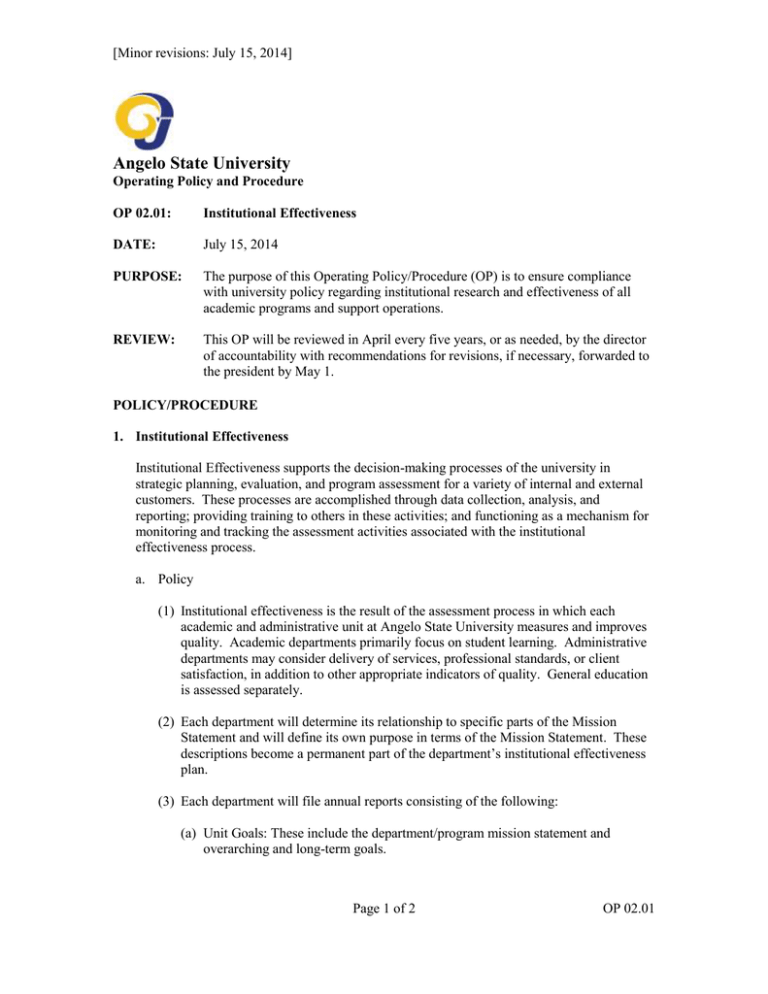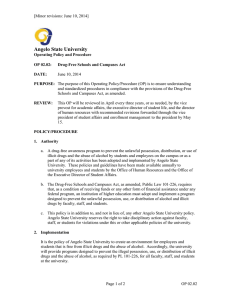Angelo State University
advertisement

[Minor revisions: July 15, 2014] Angelo State University Operating Policy and Procedure OP 02.01: Institutional Effectiveness DATE: July 15, 2014 PURPOSE: The purpose of this Operating Policy/Procedure (OP) is to ensure compliance with university policy regarding institutional research and effectiveness of all academic programs and support operations. REVIEW: This OP will be reviewed in April every five years, or as needed, by the director of accountability with recommendations for revisions, if necessary, forwarded to the president by May 1. POLICY/PROCEDURE 1. Institutional Effectiveness Institutional Effectiveness supports the decision-making processes of the university in strategic planning, evaluation, and program assessment for a variety of internal and external customers. These processes are accomplished through data collection, analysis, and reporting; providing training to others in these activities; and functioning as a mechanism for monitoring and tracking the assessment activities associated with the institutional effectiveness process. a. Policy (1) Institutional effectiveness is the result of the assessment process in which each academic and administrative unit at Angelo State University measures and improves quality. Academic departments primarily focus on student learning. Administrative departments may consider delivery of services, professional standards, or client satisfaction, in addition to other appropriate indicators of quality. General education is assessed separately. (2) Each department will determine its relationship to specific parts of the Mission Statement and will define its own purpose in terms of the Mission Statement. These descriptions become a permanent part of the department’s institutional effectiveness plan. (3) Each department will file annual reports consisting of the following: (a) Unit Goals: These include the department/program mission statement and overarching and long-term goals. Page 1 of 2 OP 02.01 [Minor revisions: July 15, 2014] (b) Objective Descriptions: These are the main focus of the unit’s effectiveness activity for the year. They do not include all unit objectives or “business as usual,” but they do include anything of special focus for the year, and, for the academic units, they include student learning objectives. (c) Assessment Measures: These define how the unit plans to measure achievement of its objectives. A combination of quantitative and qualitative measures and professional judgment can be used. Direct measures of progress are best, but indirect measures can be used along with direct measures. (d) Intended Results: This is the measurable target (e.g., 10% increase, half as many) the unit works to achieve. It is tied directly to the measurement used. (e) Actual Results: The results show the amount of actual progress that was made toward achievement of objectives and are directly related to the measurements used. (f) Use of Results: The unit will state how the results will be used to improve the quality of the program(s) or activities. If the criteria for success have been met, the department could raise the bar or could declare the objective attained and move on to another objective. Planning for the next year will depend, in part, in what is learned in the current year. (g) Budgetary Implications: If the suggested improvement has fiscal implications, the plan may be used as a supporting document for budget requests. (4) Reports will be filed electronically in the Strategic Planning Online (SPOL) software. b. Procedures (1) Reports will be filed on an annual cycle that runs from fall to fall. (2) Reports will be reviewed throughout a unit’s chain of command to ensure cohesiveness of planning among related units. Page 2 of 2 OP 02.01
